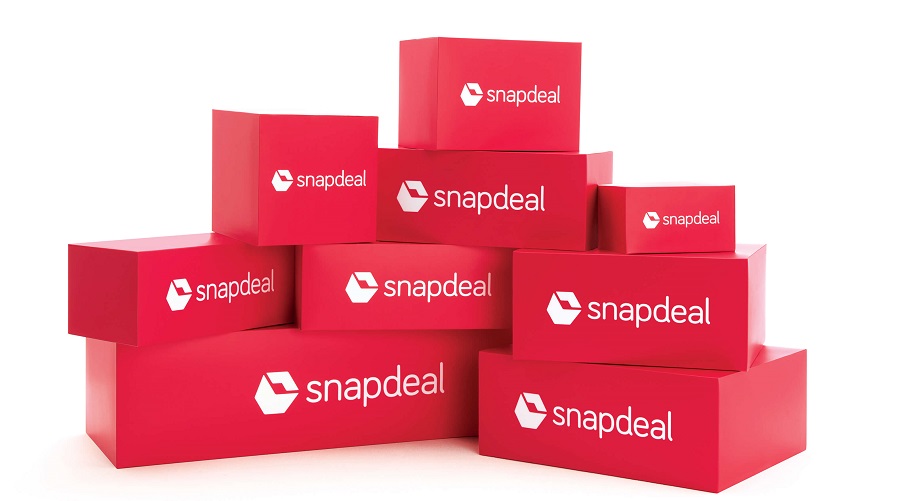
Snapdeal’s new TV commercial.
Snapdeal is back in our lives with an emotional ad campaign, playing repeatedly on every TV channel. It has pumped in about US$30 million for brand overhaul, double the amount it spent last year on its Dil ki Deal campaign with movie star Aamir Khan. This is the first rebranding effort for the six-year-old ecommerce company.
The ad campaign has made Snapdeal a topic of conversation, but will that help in storming past its big rivals in India? Snapdeal now has a solid red background color, and logo elements are rendered in white. The blue from the previous logo has been discarded. The Delhi-based ecommerce company rebranded itself with a new campaign targeting the rush around Diwali, and a fresh logo in a desperate bid to regain its lost market share.
Industry experts and analysts say that Snapdeal rebranding may help the company gain more sales on the back of Diwali rush, but “the company will have to do much more to improve its customer facing interface to race past the competitors,” says Sanchit Gogia, chief analyst and CEO of Greyhound Research. “The effort may just be too late,” he adds.

Snapdeal’s all new red delivery boxes with the new logo
Adspend chronicles
Even though Snapdeal spent heavily in the last two years on branding, it wasn’t enough to pull past competitors Flipkart and Amazon. The first major marketing campaign was launched by the company in September 2014. It positioned the brand on the back of discounts and cheap deals. The next came in 2015 when it roped in Bollywood actor Aamir Khan, desperately trying to win back trust after a slew of fake order complaints surfaced. However, the move backfired after Aamir Khan got embroiled in an “intolerance” controversy.
We faced a lot of challenges in delivery. We had issues in logistics. It took us time to put everything in the right place, and to fill up the loopholes.
With this new campaign Unbox Zindagi – meaning ‘unbox life’ – Snapdeal is pulling out all stops to advertise the brand with a fresh edge. But when it is pitched against Amazon’s witty Apni Dukan (‘our own shop’ in Hindi) festive ad campaign and Flipkart’s concept with kid-adults, Snapdeal may have a hard time convincing users to choose them over Amazon or Flipkart.
“The last few months have been challenging for Snapdeal with Amazon increasing their marketing spend and gaining market share, and Flipkart trying very hard to retain the leading market share position. This new campaign is part of creating a buzz before the crucial holiday sales season starts in India so that they can retain the market share which is essential for them to raise the next round of funding,” says Satish Meena, analyst at Forrester Research.

Screengrab from Snapdeal TV ad.
Time for change
It’s not just a superficial change Snapdeal is aiming for. The company launched an internal project called Darwin earlier this year wherein key members of the management team travelled across the country, meeting both existing and prospective shoppers in cities like Mumbai, Delhi, Kolkata, Chennai, Guwahati, Bhopal, Rajkot, Nagpur, and Madurai. The new positioning and identity is based on nearly 3,000 insights drawn from these interactions.
“We faced a lot of challenges in delivery. We had issues in logistics. It took us time to put everything in the right place, and to fill up the loopholes. We went inactive on media advertising and branding because we wanted to take time to iron out all issues. We wanted to get it right,” says Kanika Kalra, vice president marketing of Snapdeal. As a result, the company has refurbished the whole consumer experience.

Kanila Kalra, VP-marketing, Snapdeal
Product searches are simpler; customer service is much more efficient, and Snapdeal now verifies and certifies all its products for quality and genuineness, providing value assurance. All the orders will now be delivered in a red box by a delivery person wearing red. “We want to increase brand recall,” Kanika explains.
That’s not all. Tmakes he company is also refusing to let delivery boys come anywhere near you without a proper etiquette training.
Online shopping is now aspirational, it’s no longer just about discounts. It’s fashionable to shop online now.
The gravest problem Snapdeal faced was with its delivery. But now, according to Snapdeal, the company makes the fastest deliveries in the country, with an average time of 3.8 days. Flipkart and Amazon, on the other hand, take 4.5 and 4.9 days, respectively. Snapdeal can further streamline its delivery system as now it has an in-house logistic firm, Vulcan Express.
Snapdeal, launched three years after Flipkart, was once particularly popular for its flash sales. But the company has never surpassed Flipkart. In fact, the startup has been steadily losing market share to Flipkart and Amazon, which is already poking its way to dethrone Flipkart in ace position. At the end of March, Flipkart had a market share of 37 percent, down from 43 percent previous year, while Snapdeal’s market share fell to 15 percent, from 19 percent. The gainer was Amazon, which increased its market share to 24 percent, from 14 percent.
“We have to understand that concepts that have worked till now will not work anymore. Innovation is the key. Online shopping is now aspirational, it’s no longer just about discounts. It’s fashionable to shop online now. We want to tap this consumer segment,” Kanika says. It will now focus on improving customer satisfaction rather than on pricing.
The results have already started to show. After the rebranding, the number of visits to its mobile app and web portal has increased and “looks positive in long-term,” Kanika says.
Although it is still early to study statistics on how Snapdeal’s rebranding influenced consumer behaviour, even a slight uptick would mean that a fresh approach has worked. In the months before the rebrand, all consumer research on Snapdeal scored the company low on trust, customer satisfaction and service.
The company’s gross merchandise value (GMV), or the total value of goods sold through the sites increased 90 percent year-on-year in FY16 to about US$3.8 billion, according to a set of data points released by SoftBank on its India investments. The growth is much higher for Snapdeal than Flipkart, which saw about US$4.5 billion worth of shopping at the end of March 2015. However, it’s much lower than the US$10 billion target Snapdeal CEO Kunal Bahl set for 2015-16.
“We have seen a lot of traction with our Snapdeal Plus where the products are filtered by us. Last year, we got about 10 percent sales there, and today it has increased to 80 percent. The trust factor has helped,” Kanika says.
Sanchit of Greyhound agrees and says that the company’s focus has “finally” shifted to its existing customers, which will also bring down their acquisition cost. “They have brought an interface that will encourage existing users to buy more, which will also increase sales. They have realized they need to change, which is a positive thing,” he says.
“This is the opportune time for Snapdeal to dive in and capture some market share. All the companies are under pressure right now to perform. Investors are keeping a close watch on bottom line and funds are drying out. Diwali will be a level playing ground and Snapdeal can achieve a lot,” he adds.

Snapdeal Co-founder Rohit Bansal
The Alibaba impact
But analysts and investors are jittery about Alibaba’s imminent entry into the Indian ecommerce market. The Chinese online retailer is an investor in Snapdeal and Paytm, but speculations are rife that it may enter the market solo, like Amazon. Alibaba has indicated that it will enter India in 2016, but specific plans are still unknown, and in fact, a mystery. It has kept the industry waiting as to what will Alibaba’s entry mean to its investments, especially Snapdeal.
This is the opportune time for Snapdeal to dive in and capture some market share. All the companies are under pressure right now to perform.
Sanchit feels that if Alibaba comes into India’s highly competitive ecommerce sector, Snapdeal may take even longer to bridge the gap with its rivals. “It [Alibaba] is expected to enter with a lot of funds, and they are most likely to enter alone. They will immediately run for the first spot,” he says.
However, an analyst with Grand Thornton, who didn’t want to be named, says that Alibaba is likely to go after wholesale business purchases before launching a consumer facing platform. “If that happens, the incumbent players will have some time to strengthen their presence. But entry of such a high profile player is bound to hurt someone,” the analyst says. Globally, Alibaba generates more than 50 percent of its revenues from advertising.
Converted from Indian rupees. US$1 = INR 66.47
This post For Snapdeal, a rebirth and a renewed attack in the ecommerce war appeared first on Tech in Asia.
from Tech in Asia https://www.techinasia.com/snapdeal-pumps-30-million-brand-overhaul-work-dash-top
via IFTTT
No comments:
Post a Comment